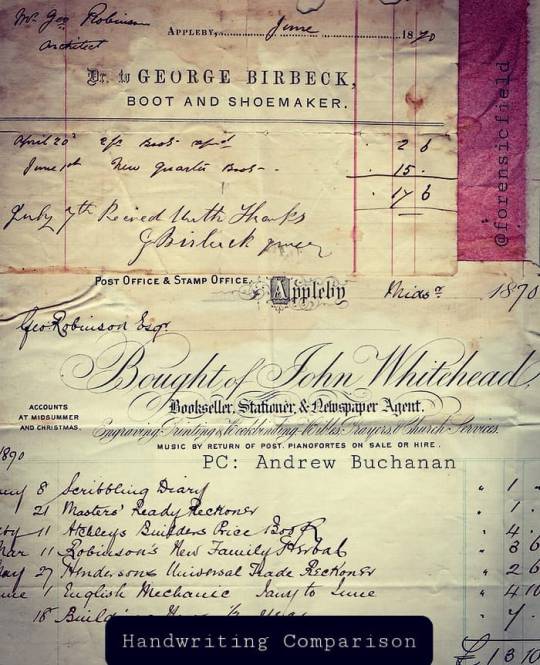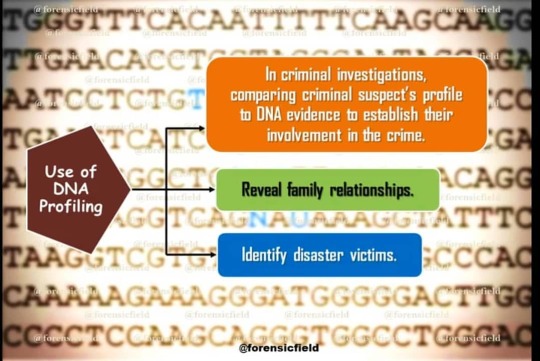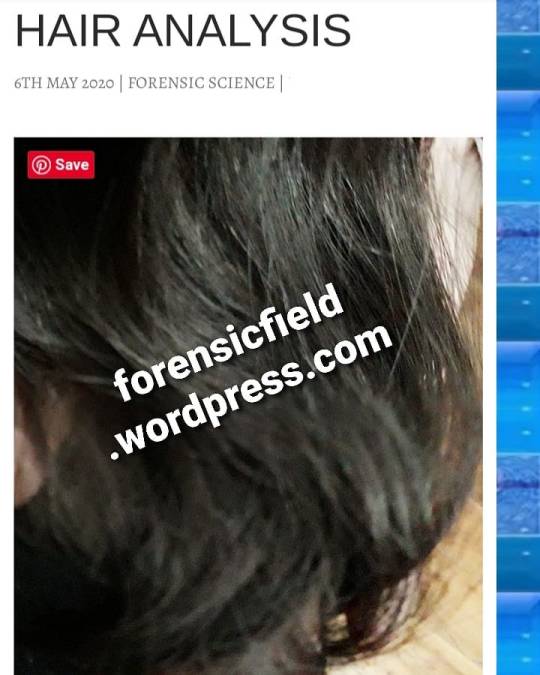#forensicsciencenotes
Photo

Footprint Analysis:-
Evaluation of two-dimensional footprint impressions for comparison purposes are carried out in the field of forensic identification by one or more of the following methods; overlay, Robbins, Gunn, Rossi and the Optical Centre Method.
Three methods for barefoot examination are commonly employed–
A.) Gunn Method:
One such method devised by Gunn involves taking multiple linear measurements of the footprints that are being compared. Gunn's basic method involves drawing six lines, five of which come from the rear foot and extend to the apex of each digit. A sixth line is then drawn across the ball of the foot at the widest area.
B.) Optical Centre Method:
A distinct point on the foot is identified and concentric circles are drawn in its most suitable location. This point is then isolated and then connected to other recognized regions of the footprint by means of lines.
C.) Overlay Method
In the overlay method, the forensic practitioner places a sheet of clear acetate over the question print. The question print may be recovered from the crime scene and presented either in its true form (for example a bloody footprint on a piece of flooring, removed in its entirety), or as a latent print (for example on lifting film) but more often than not, as a life-sized evidence photograph. A fine-tipped marker pen is used to trace around the outline of the exemplar print and the acetate then transferred and placed over the question print.
#forensic#forensicscience#forensicfield#forensicfootprintexamination#footprintanalysis#footprints#methodforfoorprintanalysis#footprint👞#forensicstudy#knowledge#crimescene#crimesceneinvestigator#criminalistic#criminology#forensicsciencenotes#forensicsciencequestionandanswer
11 notes
·
View notes
Photo

Cartridge Cases
📌 Cartridge cases are usually made of brass, a composition of 70% copper and 30% zinc.
📌Less commonly, they are made of steel or aluminum.
📌 Zinc andplastic materials have been used experimentally.
📌 Brass, plastic, and paper are used for shot-shell tubes.
📌 The main function of the cartridge case is to expand and seal the chamber against rearward escape of gases when the cartridge is fired. When a brass cartridge is fired in a weapon, the gas pressure produced by the burning of the propellant expands the case tightly against the walls of the chamber. If the brass is tempered to the correct hardness, it will spring back to approximately its original dimensions and make the case easy to extract. If the brass is too soft, it will not spring back and will make extraction difficult. If the brass is too hard, brittle, it will crack.
👉 There are three general shapes for cartridge cases:
🕵️♂️ Straight,
🕵️♂️ Bottleneck,
🕵️♂️ and, Tapered.
Almost all pistol cartridges are straight, whereas almost all rifle cartridges are bottle-necked. The bottle-neck design permits more powder to be packed in a shorter, fatter cartridge than would be possible in a straight cartridge, where the lumen is approximately the diameter of the bullet. Cartridges with tapered cases are virtually obsolete.
Watch video for more information: https://youtu.be/Y6VUcFocLoI
#forensic#forensics#forensicfield#forensicscience#forensicballistics#ballistics#gun#primer#forensicstudy#forensicknowledge#forensicnotes#cartridgecase#cartridge#pistol#forensicnetjrfpreparation#forensicmultiplechoicequestion#forensiccriminology#forensicdivision#forensicsciencenotes#forensichistoryofworld#crimescene#crimesceneinvestigator#bullet#ballisticfingerprinting#justice#criminology#criminalistic
6 notes
·
View notes
Photo

Ecotoxicology
A scientific discipline combining the methods of ecology and toxicology in studying the effects of toxic substances and especially pollutants on the environment.
Ecotoxicology is a relatively new science concerned with contaminants in the biosphere and their effects on constituents of the biosphere, including humans.
Ecotoxicology is a mix of ecology, toxicology, physiology, analytical chemistry, molecular biology, and mathematics.
Ecotoxicology perhaps started with the green wave in 1960s so as to reveal the effects of toxic substances in the environment. The first ecotoxicological model emerged in late 1970s and the first conference on the development of ecological models was held in 1980 in Copenhagen.
#forensics#forensic#forensicscience#crimesceneinvestigation#crimescene#forensicfield#forensictoxicology#ecotoxicology#biohazards#casestudy#criminalistic#criminology#forensicsciencenotes#knoweledge#forensicsciencenknowledge
4 notes
·
View notes
Photo

Question: What is the Purpose of Document Examination?
Answer: The examination of a document is conducted to determine:
✔ Origin—where did the document come from?
✔ Production source—what person or machine produced it?
✔ Production process—how was it made?
✔ Inscription—what has faded or been obliterated?
✔ Chastity—what changes, if any, have been made to it?
✔ Integrity—is it genuine or false?
✔ Legitimacy—is it an original or a reproduction, and if so, what generation?
👉 The reason for collecting this information is to shed light on events in the history of the document that have occurred prior to its arrival in court.
👉 This will enable the court to confirm assumptions that may otherwise be made.
👉 It will also allow the court to review the correspondence between the technical testimony of the document and the oral testimony of witnesses.
#forensic#forensicscience#forensics#forensicfield#forensicstudy#forensicinvestigation#crime#crimesceneinvestigation#investigation#questioneddocument#suspecteddocument#handwritingexamination#forensiclab#forensicscientist#forensicexamination#forensicsciencenotes#knowledge#law#justice
2 notes
·
View notes
Photo

Formulations for Chemical Solutions
1.) Ninhydrin (Kent, 1998; Champod et al., 2004, p 239)
Stock Solution: 25 g ninhydrin dissolved in 225 mL absolute ethanol, 10 mL ethyl acetate, 25 mL glacial acetic acid.
Working Solution: 52 mL of stock solution diluted to 1000 mL with HFE 7100.
2.) Zinc Chloride Solution (Champod et al., 2004, p 240)
Stock Solution: 8 g zinc chloride dissolved in 180 mL ethanol, 20 mL glacial acetic acid.
Working Solution: 6 mL of stock solution diluted to 100 mL with carrier solvent (e.g., HFE 7100).
3.) 1,8-Diazafluoren-9-one (DFO)
(Kent, 1998; Champod et al., 2004, p 230)
0.25 g of DFO dissolved in 30 mL methanol and 20 mL glacial acetic acid. Add this to 725 mL HFE 7100 and 275 mL HFE 71DE.
4.) Nonpolar Ninhydrin (Stimac, 2003a, pp 185–197)
Stock Solution: 1.5 g ninhydrin dissolved in 100 mL HFE 71IPA (may require refluxing at low temperature).
Working Solution: 15 mL of stock solution diluted with 100 mL HFE 7100.
5.) 1,2-Indanedione
0.25 g 1,2-indanedione dissolved in 90 mL ethyl acetate and 10 mL glacial acetic acid. Add this to 1 L of HFE 7100 (Merrick et al., 2002, pp 595–605).
or
2 g 1,2-indanedione dissolved in 70 mL ethyl acetate. Add this to 1 L HFE 7100 (Almog et al., 1999, pp 114–118).
6.) 5-Methylthioninhydrin (5-MTN) (Wallace-Kunkel et al., 2006, pp 4–13)
1.7 g 5-MTN dissolved in 52.5 mL ethyl acetate, 50 mL methyl tert-butyl ether, 12.5 mL absolute ethanol, and 5 mL glacial acetic acid. Add this to 360 mL HFE 7100.
7.) 2-Isononylninhydrin (INON, Thermanin) (Al Mandhri and Khanmy-Vital, 2005)
4–5 g INON dissolved in 15 mL ethyl acetate, 5 mL isopropanol, and 980 mL HFE 7100.
8.) Silver Nitrate (Trozzi et al., 2000, pp 38–39)
Dissolve 30 g silver nitrate in 1 L distilled water.
or
Dissolve 30 g silver nitrate in 100 mL distilled water and add to 1 L ethanol.
#forensic#forensicsciencenotes#forensics#forensicstudy#forensicscience#crimesceneinvestigation#criminalistics#criminology#forensicfield#forensicchemistry#chemicalformulations#crimescene#blooddetectionmethods#fingerprintdetectionmethod#forensicnotes#fact#knowledge#forensicknowledge
2 notes
·
View notes
Photo

Q:- Why soil is considered as an Evidence?
Ans:- Forensic soil scientists consider soil as any earth material that has been collected accidentally or on purpose and is related to the problem they are investigating. Though the technology isn’t perfect, soil forensics is considered as an important wing during investigations.
Soil in includes rock, minerals, vegetation, glass, paint, asphalt, etc. The presence of these objects in that area helps to make that area of soil unique from other areas.
Q:- What quantity of soil sample is required ?
Ans:- In most forensics cases, only about one cup of the top layer of soil needs to be collected.
Q:- How analysis should be performed?
Ans:- Samples are dried before testing, to prevent further decomposition of the material in the soil.
👉 At the crime lab, the forensic soil scientist conducts chemical and physical analysis tests and compares the soil samples from the crime scene location with the soil sample found on the suspect or on his or her belongings.
👉 Another test for soil is ground-penetrating radar technology (GPR).
Scientist use radar energy pulses to look for breaks in the soil’s structure. GPR helps detect anomalies in the soil, where radar energy is sent back to the receiving antennae. But the drawback- it is not always accurate, especially with heavy clay soils.
In the end, with the use of soil forensics and GPR technology, scientists and investigators can make connections between differences in the soil and collected evidence. By identifying by the individual characteristics of soil, investigators can use this knowledge to help solve crimes.
href="https://www.instagram.com/p/CDOTtE4FMrH/?igshid=1ek3f6zl7bqi2">https://www.instagram.com/p/CDOTtE4FMrH/?igshid=1ek3f6zl7bqi2
#forensicdivision#forensics#forensic#forensicsciencenotes#soilevidence#soilanalysis#physicalevidence#criminology#criminalistic#forensiccasestudy#forensicevidence#forensicscience#forensicfield#forensicsoiltest#bilogicalevidence#crime
3 notes
·
View notes
Photo

Astronomers detected signs of a smelly, toxic gas Phosphine, that microbes can make in the planet’s clouds
Question- What is Phosphine?
Answer- Phosphine is the compound with the chemical formula PH3, classed as a pnictogen hydride. It is a colorless, flammable, very toxic gas. Pure phosphine is odorless, but technical grade samples have a highly unpleasant odor like garlic or decaying fish, due to the presence of substituted phosphine and diphosphane (P2H4). With traces of P2H4 present, PH3 is spontaneously flammable in air (pyrophoric), burning with a luminous flame.
IUPAC name: phosphane
Question- How is Phosphine made?
Answer- Phosphine is a constituent of the Earth’s atmosphere at very low and highly variable concentrations.
Phosphine is also made naturally by some species of anaerobic bacteria—organisms that live in the oxygen-starved environments of landfills, marshlands, and even animal guts.
phosphine can only be made by life whether human or microbe. It had also been used as a chemical weapon during World War I.
Phosphine is manufactured as an agricultural fumigant, is used in the semiconductor industry, and is a nasty byproduct of meth labs.
Question- Is phosphine gas Toxic?
Answer- The Immediately Dangerous to Life or Health level is 50 ppm. Overexposure to phosphine gas causes nausea, vomiting, abdominal pain, diarrhea, thirst, chest tightness, dyspnea (breathing difficulty), muscle pain, chills, stupor or syncope, and pulmonary edema.
#forensic#forensictoxicology#toxic#poison#phosphine#toxicgas#venus#poisondefinition#toxicityofphosphine#forensiccriminology#forensicsciencenotes#forensicscience#criminalistic#forensicfield#forensiclab#toxanalysis#smellofphosphine#forensicmultiplechoicequestion#forensicnetjrf#forensicsciencemcq
1 note
·
View note
Photo

An easy notes on Basic forensic science (https://youtu.be/EMqQXcNkIvc). Forensic Science is the application of sciences such as physics, chemistry, biology etc. Forensic Scientists examine how blood spatter patterns occur, learn the composition and source of evidence such as drugs and trace materials and also determine the identity of an unknown suspect . Forensic Science plays a important role in the criminal justice system by providing scientifically based information by analysis of evidences. During an investigation, evidence is collected at a crimescene, analyzed in a forensic laboratory and then the results presented in court . Each crime scene is unique, and each case is different presents its own challenges. Forensic Scientists should have the good eyesight and sharp mind for examination & analysing of evidences and crimescene. watch many more videos related to forensics. https://www.youtube.com/c/forensicfield Like it✅, Share it↩ and don't forget to Subscribe the channel✔..... -------------------------------------------------------------------------------- #forensic #forensicscience #forensicfield #crime #crimescene #crimesceneinvestigation #investigation #forensicinvestigation #basicforensicscience #forensicsciencenotes #easyforensic #netjrf #forensicstudy #criminology #criminalistics #legal #police #forensicexamination https://www.instagram.com/p/B_4Djm1lMw5/?igshid=5ewu5e92z834
#forensic#forensicscience#forensicfield#crime#crimescene#crimesceneinvestigation#investigation#forensicinvestigation#basicforensicscience#forensicsciencenotes#easyforensic#netjrf#forensicstudy#criminology#criminalistics#legal#police#forensicexamination
1 note
·
View note
Photo

DNA profiling in Forensic Science Know more about DNA and it's usage... Watch the video... https://youtu.be/GplYJlOMfSk Like it✅, Share it↩ and don't forget to Subscribe the channel✔..... -------------------------------------------------------------------------------- #forensic #forensicscience #forensicfield #crime #crimescene #crimesceneinvestigation #investigation #forensicinvestigation #basicforensicscience #forensicsciencenotes #easyforensic #netjrf #forensicstudy #criminology #criminalistics #legal #police #forensicexamination https://www.instagram.com/p/B_7_Zz-jAAj/?igshid=1dgf4h7yteer2
#forensic#forensicscience#forensicfield#crime#crimescene#crimesceneinvestigation#investigation#forensicinvestigation#basicforensicscience#forensicsciencenotes#easyforensic#netjrf#forensicstudy#criminology#criminalistics#legal#police#forensicexamination
0 notes
Photo

Know about Hair Characteristics and differences General Differences between Human Hair and Animal Hair Feature Colour Relatively consistent along shaft,Often showing profound colour changes and banding Cortex Occupying most of the width of shaft greater than medulla Usually less than width of medulla Distribution of pigment Even, slightly more towards cuticle Central or denser towards medulla Medulla [ 426 more words ] https://forensicfield.wordpress.com/2020/05/06/hair-analysis/ (LINK In BIO) Follow For more articles》forensicfield.wordpress.com -------------------------------------------------------------------------------- #forensic #forensicscience #forensicfield #crime #crimescene #crimesceneinvestigation #investigation #forensicinvestigation #basicforensicscience #forensicsciencenotes #easyforensic #netjrf #forensicstudy #criminology #criminalistics #legal #police #forensicexamination https://www.instagram.com/p/B_27wHalIoa/?igshid=c30o5yvj1vkz
#forensic#forensicscience#forensicfield#crime#crimescene#crimesceneinvestigation#investigation#forensicinvestigation#basicforensicscience#forensicsciencenotes#easyforensic#netjrf#forensicstudy#criminology#criminalistics#legal#police#forensicexamination
0 notes
Text
FORENSIC SCIENCE E-BOOK ON UNIT-II OF SYLLABUS OF NET/JRF
FORENSIC SCIENCE E-BOOK ON UNIT-II OF SYLLABUS OF NET/JRF
Instrumentation notes according to syllabus of forensic science net/jrf. Read it now...
---
#forensicsciencenotes
#forensic
#forensicnotes #forensicnetjrf
#forensicbook
#forensicstudy
#forensics
Do not forget to subscribe our newsletter for instant updates of New posts and e-books.
View On WordPress
#forensic net jrf preparations#forensic notes notes according syllabus#forensic science unit i notes#forensic Science unit II notes#forensic science unit wise notes for net jrf syllabus#instrumentation in forensic science#instrumentation notes#instruments in forensic#unit ii of net syllabus
1 note
·
View note